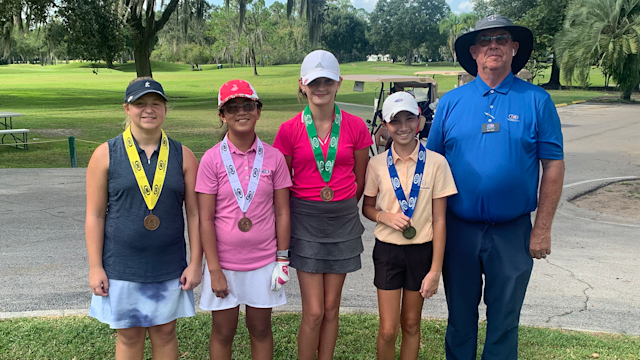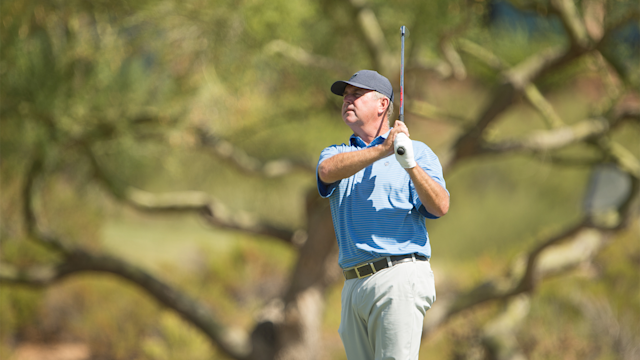Game Changers
Learning How to Shift My Weight — My Journey in Golf & Mindfulness
By Kevin Hyland
Published on

The sun shines on the sixth hole on the East course at PGA Frisco. (Photo by Matt Hahn/PGA of America)
In the summer of 1997, I came to Errie Ball to save my future– as I was 100% convinced that I threw it in a lake with my Great Big Bertha the week prior in an episode of anger and rage.
Desperate and despondent, I arrived early to our first session and an attendant shuffled me through the lot to Errie’s perfectly appointed office in the corner of the driving range at Butler National.
“I’m here to fix..”
Before I could finish my sentence, Errie smiled, gestured to me to remove my hat and extended a strong right hand that felt so much younger than 87 and so much larger than it should have for a man that stood 5’6”. I removed my hat, shielded the sun and extended a meek right hand to meet him. Errie then brought his left hand up to my right shoulder, and in a glance that seemingly lasted forever, he looked right through me into the depth of my soul.
Fully uncomfortable and on the verge of something that felt like tears, I quickly reached back to a familiar place and started beating 8-irons on a rope into the skyline. After a few moments, I rose from my daze to look up and find him smiling. Errie motioned to my bag. I grabbed my 5-iron. Flush. Flush. Flush. I looked up, and his smile persisted. Another nod to my bag. This wordless chorus went on for 20 minutes as I worked through every club in the bag but the one I couldn’t hit.
“Well, I can’t show you the problem I’m having. I threw it in a lake and I haven’t had a chance to…”
Errie laughed.
“I just snapped. I stood on the tee with everything in front of me. Winning. College. Life. I hate that #%#@#% driver. I #%#@#%# hate… Sorry. I just can’t.”
My mind whipped me backwards to the meltdown on the tee box. Tears welled in my eyes.
Errie looked me dead in the eyes and in perfectly measured Welsh prose he delivered a message that I can still hear crystal clear today.
“No, son. You certainly can. And you already know the how and why of your weight and where it should go.”
I hit a few more perfect irons in wildly uncomfortable silence. We shook hands, and I walked back to the lot to find my Jeep.My mind raced… What does he mean that I already know? If I knew already, why can’t I do it?! What the $%$$?!
Errie and I met several more times that summer, and as I spoke more and more, he said less and less. But that same refrain showed up with a calming smile time and time again. “You already know, son. You already know.”
With heaps of practice, the new driver got a bit straighter– but more importantly, the club-tossing-miss felt entirely different within me.
And while I never learned how to be an elite driver of the golf ball in my work with Errie, I somehow discovered that I already knew where the weight should shift in my approach to the game and that a golf club of mine would never again find the lake in its path.
It’s been 25 years since PGA Hall of Famer Errie Ball and I spent quality time in his office. And while he’d be happy to know that I’ve thrown exactly zero clubs since then, our “therapy sessions” that formative summer failed to completely rid my world of the anger, anxiety and depression that lived beneath the actions of that 17-year old golfer who thought his only issue was an inability to hit the driver. That nasty triumvirate of mental anguish still shows up today in different ways like unwanted shanks in the middle of a match. But through a resounding belief in Errie’s infinite wisdom to always return to what I know, (+ a lot of hard work and a steady diet of visits to more traditional therapists / life coaches), I’ve found the power to not only move forward but to make a hell of a lot more birdies in life than bogeys.
In the last 25 years, I’ve hit a lot of golf balls, too– both on the driving range, on the golf course, and in my mind in the anxious insomnia-laden hours of the evening when the rest of my family is fast asleep. A short bit ago, I “hit” a tee shot I’ll never forget. I was working with an EMDR* guide on revisiting a place of joy. And in what might be one of the most powerful experiences of my life, I was able to travel from my home office in Dallas to the first tee of the golf course I grew up at in Chicago and get fully enveloped in an experience that tapped into all five senses. I could smell the grass. Hear the birds. See the line over the right half of the bunker. Touch the dimples of a dated balata ball and the grain of the tees in my pocket. I could even taste the julien chicken fingers I had eaten at the snack bar.
Ah, the mind is so much more powerful than my driver will ever be.
I’m not sure exactly when this weight shift happened in my golf journey, but we’ve moved together from an elite player chasing scratch to a friend, dad & father chasing serenity. The highs of outdriving buddies on the golf course are now trumped in importance by the drivers I hit when my eyes are closed and my world melts away into a pure visualization of the simplicity of movement. In golf, I’ve found something akin to zen and it truly makes me a better version of myself.
Errie knew I knew. It’s just taken a lot of life for me to remember.
*Eye movement desensitization and reprocessing (EMDR) is a form of psychotherapy developed by Francine Shapiro in the 1980s that was originally designed to alleviate the distress associated with traumatic memories such as post-traumatic stress disorder.


